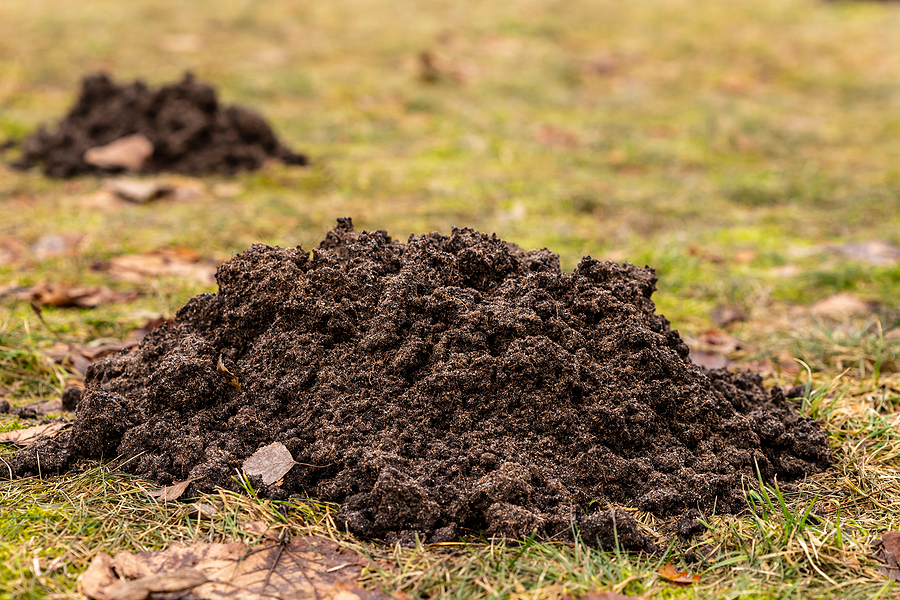Are you fed up with moles wreaking havoc in your yard? If so, you’re not alone. Nuisance moles can be a huge problem for homeowners and can cause damage to the lawn and landscape. Unfortunately, controlling these pesky critters is no easy task either!
Continue below to learn how to spot the signs of a yard mole problem, plus what you can do to get rid of moles for good!

Facts About Lawn Moles
Moles are small mammals that live underground and feed on worms, grubs, and other insects. They have distinctive star-shaped footprints and move quickly through the soil. Moles dig extensive tunnel systems beneath lawns, which can cause significant damage to the grass and plants above ground. These tunnels form mounds of dirt that are unsightly and can make walking or mowing a lawn difficult.
Signs of Moles in the Lawn
Moles are one of the most common backyard pests, and they can cause quite a bit of damage to your yard. If you notice that your grass is being ripped up or tunnels in the ground, then it’s likely that there’s a mole living under your lawn.
Here are some of the top signs of a mole problem on your property:
▶ Tunnels and Mounds: Moles dig tunnels under your lawn, which can be seen as mounds along the surface or small ridges with patches of raised soil. These tunnels are usually about 2-4 inches wide and may have grass growing on top of them.
▶ Dead Grass Patches: Another sign of a mole problem is dead grass patches. Moles can feed on the roots of grass, causing it to die or appear unhealthy due to lack of water or nutrients.
▶ Insects and Worms: Moles feed on small insects such as worms, grubs, and even centipedes. If you find an unusually large amount of these creatures on your property , then there’s a good chance that they are being attracted by the mole living underneath.
▶ Noises: Moles also make noise as they tunnel under the ground, which can be heard as a light tapping sound or squeaking noises. If you hear this kind of noise coming from your premises, then you may have a mole problem.
Yard Mole Control Tips
If you suspect that you have a mole problem in your yard, it’s important to take steps to get rid of them quickly. Moles can cause extensive damage to your lawn and garden, so it’s important to act fast. You can use traps or poisons to get rid of moles in your yard, but it’s best to contact an Indianapolis wildlife control company if the issue persists.
The best way to reduce mole damage is to make your property less attractive to them in the first place. Start by removing potential food sources—such as grubs, worms, and other insects—from the soil. You can also try using a variety of repellents, like castor oil or peppermint oil, to make the yard less appealing. If these tactics don’t work, it may be time to consider trapping or baiting moles in order to get rid of them.
Mole removal and control can be tricky and requires patience and persistence. Ultimately, it is important to remember that it is not possible to completely eliminate moles from your yard. However, with the right strategies, you can reduce their destructive behavior and keep your lawn looking its best.
How to Get Rid of Moles in Indiana
If nuisance moles are proving to be a problem in your lawn or garden, don’t despair! Take action now to protect your landscape and make sure that these pesky critters stay away for good. Don’t let those moles ruin your perfectly manicured lawn—take charge of the situation today and get rid of the nuisance once and for all!
Are you ready to take on nuisance moles? Don’t delay any longer—start fighting back against these pesky critters now! Contact Modern Wildlife Control at 317-847-6409 for safe and effective animal trapping and removal services for yard moles in Indianapolis, Indiana and its surrounding counties. We serve residential and commercial customers.
Related Posts:
How to Manage Yard Mole Removal and Control Season
Are Moles and Voles the Same Animal?
How to Tell if You Have Nuisance Animal Problems
